
The Teloschistaceae are a large family of mostly lichen-forming fungi belonging to the class Lecanoromycetes in the division Ascomycota. The family, estimated to contain over 1800 species, was extensively revised in 2013, including the creation or resurrection of 31 genera. It contains three subfamilies: Xanthorioideae, Caloplacoideae, and Teloschistoideae. A fourth subfamily, Brownlielloideae, proposed in 2015, has been shown to be part of the Teloschistoideae.
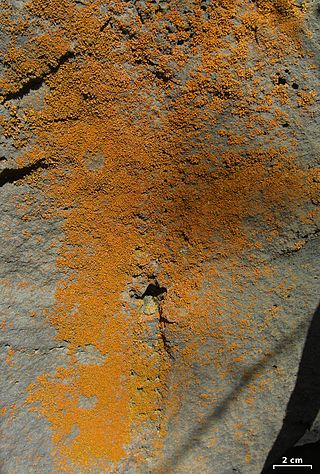
Xanthomendoza is a genus of small, bright orange foliose lichens with lecanorine apothecia. It is in the family Teloschistaceae. Members of the genus are commonly called sunburst lichens or orange lichens because of their bright orange color.
Neobrownliella brownlieae is a species of saxicolous (rock-dwelling), crustose lichen in the family Teloschistaceae. It is widely distributed in Australia.
Fulgogasparrea decipioides is a species of lichen in the family Teloschistaceae. It is found in Gangwon Province, South Korea. This species was originally described in 2011by Ulf Arup as a member of the large genus Caloplaca. The specific epithet decipioides refers to its similarity with Caloplaca decipiens. Arup and colleagues transferred it to genus Wetmoreana in 2013, before it was again transferred to Fulgogasparrea that same year, a genus in which it is the type species.
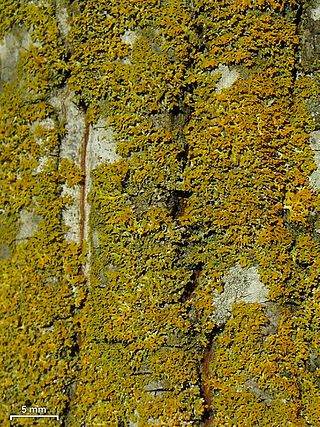
Gallowayella is a genus of lichen-forming fungi in the family Teloschistaceae. It has 15 species. The genus was circumscribed in 2012 by Sergey Kondratyuk, Natalya Fedorenko, Soili Stenroos, Ingvar Kärnefelt, Jack Elix, and Arne Thell, with Gallowayella coppinsii assigned as the type species. The generic name honours New Zealand lichenologist David John Galloway (1942–2014).
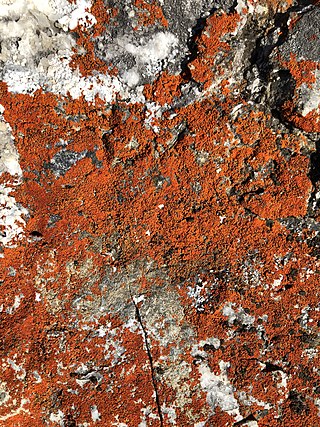
Igneoplaca is a genus in the subfamily Xanthorioideae of the family Teloschistaceae. It contains a single species, the crustose lichen Igneoplaca ignea.
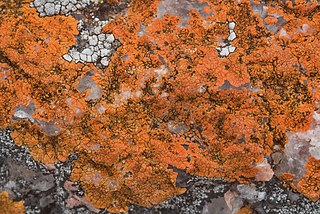
Fulgogasparrea is a genus of crustose lichens in the subfamily Xanthorioideae of the family Teloschistaceae. It has five species. The genus was circumscribed in 2013, with Fulgogasparrea decipioides assigned as the type species; this lichen had originally been formally described as a species of Caloplaca, and then a couple of years later transferred to Wetmoreana. Six are credited with authorship of the genus: Sergey Kondratyuk, Jeong Min-hye, Ingvar Kärnefelt, John Alan Elix, Arne Thell, and Jae-Seoun Hur. The genus name alludes to the resemblance of the type species with both of the Teloschistaceae genera Fulgensia and Gasparrinia.
Ovealmbornia is a monotypic genus of mostly foliose lichen species in the subfamily Xanthorioideae of the family Teloschistaceae. It now only contains one known species, Ovealmbornia reginae as others were classed as synonyms of other species in the same family.
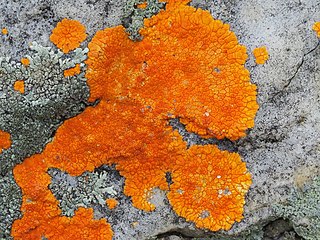
Brownliella is a genus of crustose lichens in the subfamily Brownlielloideae of the family Teloschistaceae. It has four species. The genus was circumscribed in 2013 by Sergey Kondratyuk, Ingvar Kärnefelt, John Elix, Arne Thell, and Jae-Seoun Hur, with the widely distributed lichen Brownliella aequata assigned as the type species. The genus contains species formerly referred to as the Caloplaca cinnabarina species group. The generic name honours Australian botanist Sue Brownlie.
Sirenophila is a genus of crustose lichens in the subfamily Teloschistoideae of the family Teloschistaceae. It has four species with an Australasian distribution.
Kaernefia is a genus of crustose lichens in the family Teloschistaceae. It has three species, found in Australia or South Africa.
Filsoniana is a genus of squamulose lichens in the family Teloschistaceae. It has six species. It was circumscribed in 2013 by Ingvar Kärnefelt, Arne Thell, Jae-Seoun Hur, Sergey Kondratyuk, and John Elix following a molecular phylogenetic analysis of the Teloschistaceae. The generic name honours Australian lichenologist Rex Filson, "in recognition of his contribution to lichenology, in particular to the lichen flora of Australia".
Huneckia is a genus of crustose lichens in the subfamily Caloplacoideae of the family Teloschistaceae. It has four species.

Oxneria is a genus of foliose lichens in the family Teloschistaceae. It has four species. The genus was circumscribed in 2003 by Sergey Kondratyuk and Ingvar Kärnefelt, with Oxneria alfredii assigned as the type species.
Gallowayella aphrodites is a species of corticolous (bark-dwelling), foliose (leafy) lichen in the family Teloschistaceae. It is found in the Mediterranean countries Greece, Cyprus, and Italy. Characteristics of the lichen include its small thallus, the disposition of the rhizines on the thallus undersurface, and the lack of vegetative propagules.
Neobrownliella is a genus of crustose lichens in the subfamily Teloschistoideae of the family Teloschistaceae. It has five species. The genus was circumscribed in 2015 by lichenologists Sergey Kondratyuk, Jack Elix, Ingvar Kärnefelt, and Arne Thell, with Neobrownliella brownlieae assigned as the type species. It is a segregate of the large genus Caloplaca. Characteristics of Neobrownliella include a thallus that is continuous or areolate, the presence of anthraquinones as lichen products, a cortical layer with a palisade paraplectenchyma, and the lack of a thick palisade cortical layer on the underside of the thalline exciple. Two species were included in the original circumscription of the genus; an additional three species were added in 2020.
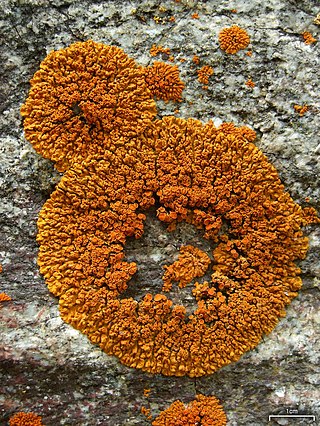
Golubkovia is a single-species genus in the family Teloschistaceae. It contains the species Golubkovia trachyphylla, a crustose lichen. The genus was circumscribed in 2014 by Sergey Kondratyuk, Ingvar Kärnefelt, John Elix, Arne Thell, and Jae-Seoun Hur. The generic name honours Russian lichenologist Nina Golubkova (1932–2009), who, according to the authors, "made important contributions to lichenology in northern Eurasia".
Mark Richard David Seaward is a British ecologist and lichenologist. He was awarded the Acharius Medal in 2006 for lifetime contributions to lichenology.

Wetmoreana is a genus of lichen-forming fungi in the family Teloschistaceae. It has two crustose, saxicolous (rock-dwelling) species.









